Common morphological processing includes erosion, dilation, opening operation, and closing operation. Different operations have different effects, and the same operation has different effects on different types of pictures. The specific effects are shown in the table below. Proficiency in morphological processing of binary images is required.
1. Processing of binary images
1. Structural elements
Before starting the morphological operation, the structuring elements are prepared, usually the structuring elements are convex and have a reference point.

We will slide the reference point of the structural element over each pixel of the image to be processed, and consider the relationship between the structural element and the image area at this time. The following defines a structural element, and the picture effect and value of the structural element are shown in the following figure:
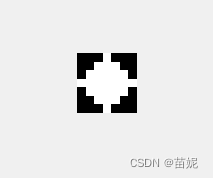
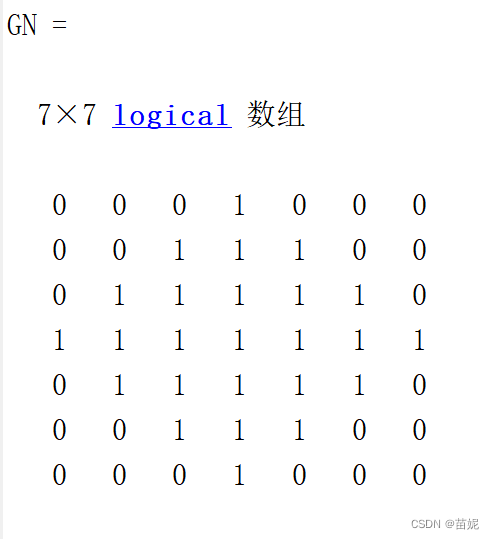
SE = strel('diamond',3);
GN=getnhood(SE)%获取结构元素的邻域
figure,imshow(GN,[]);
2. Corrosion
The role of corrosion is to mark the position where the structural elements appear in the original image, and the marked position is the position of the reference point.

Image=imread('menu.bmp'); %打开图像
BW=im2bw(Image); %转换为二值图像
subplot(131),imshow(BW);title('原图像');
[h w]=size(BW); %获取图像尺寸
result=ones(h,w); %定义输出图像,初始化为1
for x=2:w-1
for y=2:h-1 %扫描图像每一点,即结构元素移动到每一个位置
for m=-1:1
for n=-1:1 %当前点周围3×3范围,即3×3结构元素所覆盖范围
if BW(y+n,x+m)==0 %该范围内有像素点为0,即该位置不能完全包含结构元素
result(y,x)=0; %将参考点记录为背景点,即腐蚀掉
break;
end
end
end
end
end
subplot(132),imshow(result); title('自编程实现二值图像腐蚀');
SE=strel('square',3); %创建结构元素
result=imerode(BW,SE); %腐蚀运算
subplot(133),imshow(result); title('二值图像imerode');
3. Expansion
Expansion has the effect of making the binary image visually thicker. The direction of expansion depends on the structural element. Take the structural element in the following figure as an example. There are two pixels above and below the reference point of the structural element, so the original image of this structural element Dilates by two pixels in both the up and down directions.
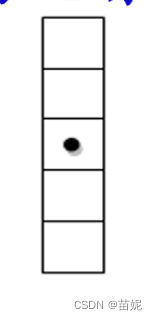

Image=imread('menu.bmp'); %打开图像
BW=im2bw(Image); %转换为二值图像
subplot(131),imshow(BW),title('显示原图像');
[h w]=size(BW); %获取图像尺寸
result=zeros(h,w); %定义输出图像,初始化为0
for x=2:w-1
for y=2:h-1 %扫描图像每一点,即结构元素移动到每一个位置
for m=-1:1
for n=-1:1 %当前点周围3×3范围,即结构元素为3×3大小
if BW(y+n,x+m) %结构元素所覆盖3×3范围内有像素点为1,即交集不为空
result(y,x)=1; %将参考点记录为前景点
break;
end
end
end
end
end
subplot(132),imshow(result);title('自定义实现二值图像膨胀');
SE=strel('square',3); %创建结构元素
result1=imdilate(BW,SE); %膨胀运算
subplot(133),imshow(result1);title('imdilate实现二值图像膨胀');
4. Open and close operations
The opening operation is to use the same structural element to first corrode and then expand the original image. The common application is to eliminate isolated noise points and slender burrs outside the target of interest (the size is smaller than the structural element).
The closing operation is to use the same structural element to expand and then corrode the original image. The common application is to eliminate the holes inside the target of interest.

Image=imread('A.bmp');
BW=im2bw(Image);
SE=strel('square',3);
result1=imdilate(imerode(BW,SE),SE);
result2=imopen(BW,SE); %用3×3结构元素进行开运算
figure,imshow(result1);title('开运算方法1');
figure,imshow(result2);title('开运算方法2');
result3=imerode(imdilate(BW,SE),SE);
result4=imclose(BW,SE); %用3×3结构元素进行闭运算
figure,imshow(result3);title('闭运算方法1');
figure,imshow(result4);title('闭运算方法2');5. Morphological filtering
As the name implies, the original image content with a fixed shape is extracted from the image, and the extracted shape is consistent with the shape of the structural element. Here, the open operation is used to implement, first corrode and then expand. The size of the structural element during corrosion needs to be larger than the unwanted shape, smaller than The size of the shape that you want to keep; after such erosion, it can be guaranteed that only the target shape of interest is left, so that it can be restored to the size of the original shape after expansion.

Image=imread('pattern.jpg');
Th=graythresh(Image);
OriginBW=im2bw(Image,Th);
subplot(131);imshow(OriginBW);title('原始二值图像');
imwrite(OriginBW,'pattern1.bmp');
BW1=1-OriginBW;
se=strel('square',3);%结构元素为边长为3的正方形
BW2=1-imopen(BW1,se);
subplot(132);imshow(BW2);title('矩形块提取');
imwrite(BW2,'rectang1.bmp');
se45=strel('line',25,45);%结构元素为角度为45的线,长度为25个像素
BW3=1-imopen(BW1,se45);
subplot(133);imshow(BW3);title('线段提取');
imwrite(BW3,'line1.bmp');
6. Smoothing
The internal and external noise of the target image is removed by the operation of first opening operation and then closing operation.
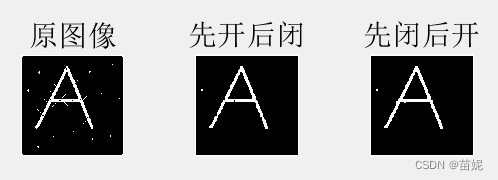
Image=imread('A.bmp');
BW=im2bw(Image);
subplot(131);imshow(BW);title('原图像');
SE=strel('square',4);
result1=imclose(imopen(BW,SE),SE); %用3×3结构元素先开后闭
subplot(132);imshow(result1);title('先开后闭');
result2=imopen(imclose(BW,SE),SE); %先闭后开
subplot(133);imshow(result2);title('先闭后开');
7. Hit and miss
This is a bit like target detection. Not only the internal shape needs to satisfy the structural elements, but also the external shape needs to satisfy the structural elements. The processing result marks the found position that meets the requirements.
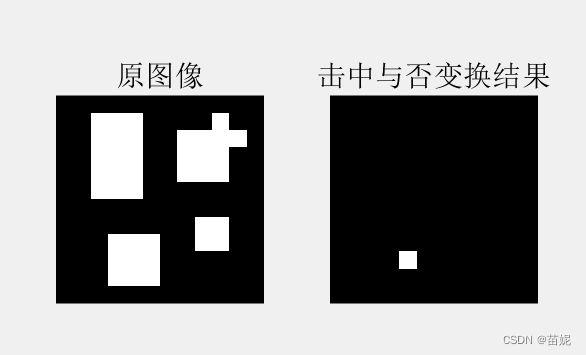
Image=zeros(12,12); %定义目标图像Image
Image(2:6,3:5)=1;
Image(9:11,4:6)=1;
Image(3:5,8:10)=1;
Image(8:9,9:10)=1;
Image(2,10)=1;
Image(3,11)=1;
SE1=[0 0 0 0 0 %定义结构元素SE1
0 1 1 1 0
0 1 1 1 0
0 1 1 1 0
0 0 0 0 0];
SE2=[1 1 1 1 1 %定义结构元素SE2
1 0 0 0 1
1 0 0 0 1
1 0 0 0 1
1 1 1 1 1];
subplot(121),imshow(Image); title('原图像');
result1=imerode(Image,SE1); %结构元素SE1探测图像内部,结果为result1
Image1=~Image; %目标图像Image求补
result2=imerode(Image1,SE2); %结构元素SE2检测图像外部,结果为result2
result=result1 & result2; %求出击中与否变换的结果result
subplot(122),imshow(result); title('击中与否变换结果');
2. Processing the grayscale image
1. Corrosion and expansion
After corroding the grayscale image, the overall image becomes darker, and the bright details are weakened; after the grayscale image is expanded, the image becomes brighter overall, and the dark details are weakened; in short, after the corrosion expansion process, the image will become blurred; for color images After expansion and corrosion treatment, is there an effect of oil painting~
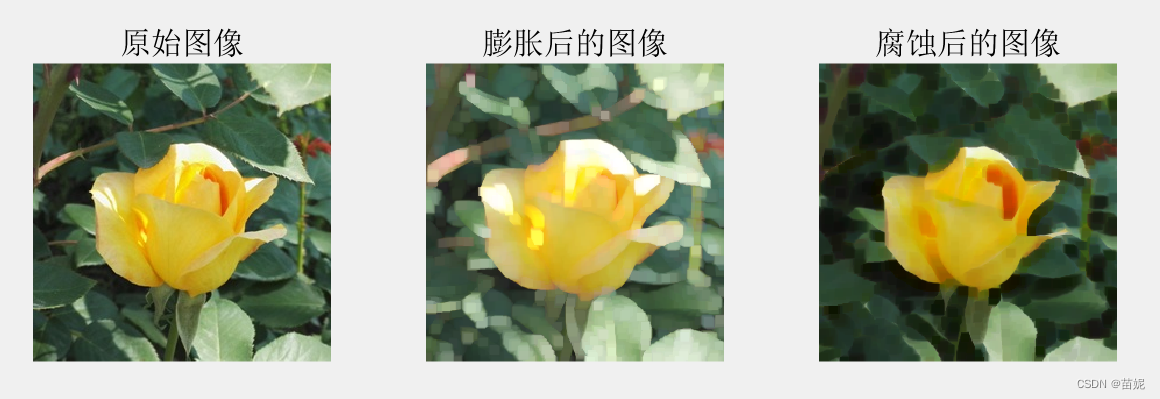

Image=(imread('maleman.gif'));
se=strel('ball',5,5);%选取球形结构元素
result1=imdilate(Image,se);%膨胀灰度图像
result2=imerode(Image,se); %腐蚀灰度图像
imshow(Image);title('原始灰度图像');
figure,imshow(result1);title('膨胀后的图像');
figure,imshow(result2);title('腐蚀后的图像');
imwrite(result1,'ym1.bmp');
imwrite(result2,'ym2.bmp');